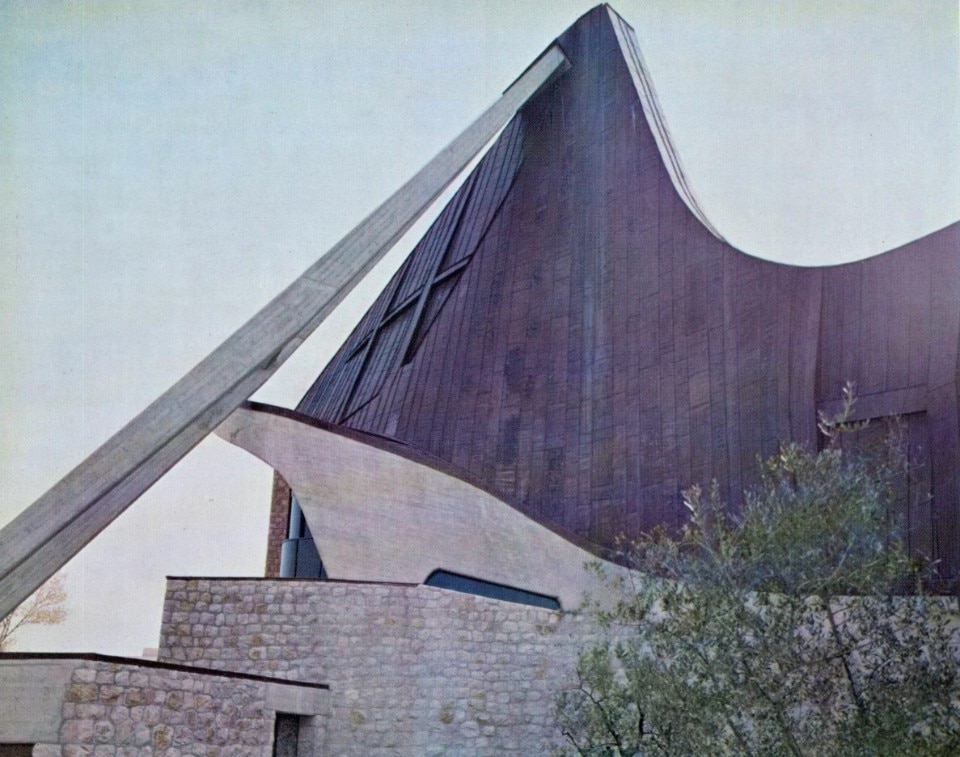To Michelucci, on the San Giovanni church
This work is an Italian expression of architecture and art, and it is also Italian because all roads in Italy encounter monuments and works of art on their way; so a new Italian highway could not lack them.
When I saw this work by Michelucci at its first presentation, with other guests, Fr. Pellegrino, who was present, asked me if I wanted to say a few words. He intended for me to say them to a recorder for Vatican Radio. On the other hand, I had understood that I had to say a few moving words of my own to the bystanders, and I was eager to express my opinion: I fidgeted and wrote down a few notes. Then I understood, disappointed and confused, my blunder (and I failed to speak into the microphone, with my eyes then on the winding wheels of the relentless mechanism, words becoming a chant, out of modesty that others should hear and see us emitting words aloud in the orifice of an instrument).
But those notes reappeared to me, and now tempt me to give that speech again, here, the least critical-architectural ever given in the world.
By speaking critically and making judgments, there is a danger that people will hastily make a prefabricated judgment biased by our own, never to think about it again. It matters instead to help people mature their own judgments, and so we instead make, from these pages, in the words that comment on them, an invitation to see this eminent work, and perhaps to take courage and approach the architect who – as valuable architects are – is a “living” man.
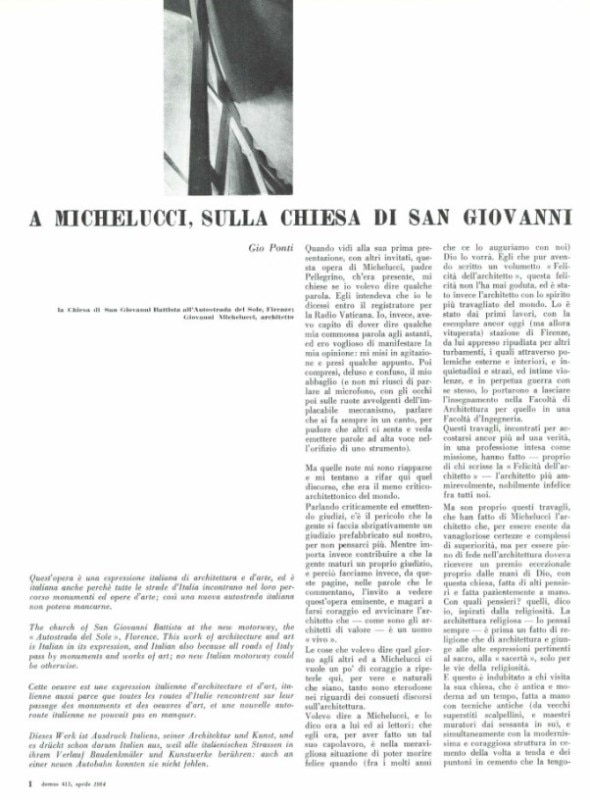
It takes some courage to repeat here the things I wanted to say that day to others and to Michelucci, true and natural as they may be, for how heterodox they are in regard to the usual discourses on architecture.
I wanted to say to Michelucci, and I say it now to him and to the readers: that he now, for having made such a masterpiece of his own, is in the wonderful situation of being able to die happily when (after the many years we wish him with us) God wills it.
He, who wrote a little volume, “Happiness of the Architect”, still never enjoyed this happiness, having been instead the architect with the most troubled spirit in the world. He was so from his earliest works, with the railway station in Florence, exemplary today (but then vituperated), which he later repudiated because of other disturbances, which through external and internal controversies, and restlessness and heartbreak, and intimate violence, and in perpetual war with himself, led him to leave teaching in the Faculty of Architecture to join a Faculty of Engineering.
Such travails, encountered in order to get even closer to a truth, in a profession understood as a mission, made – of the very one who wrote the “Happiness of the Architect” – the most admirably, nobly unhappy architect among us all.
But it is precisely these travails, which have made Michelucci the architect who, in order to be free from boastful certainties and superiority complexes, but to be full of faith in architecture, had to receive an exceptional prize from the very hands of God, with this church, made of high thoughts and patiently made by hand. With what thoughts? those, I say, inspired by religiosity. Religious architecture – I always thought so – is more a matter of religion than of architecture, and it reaches the high expressions pertinent to the sacred, to “sacredness”, only through the ways of religiosity.
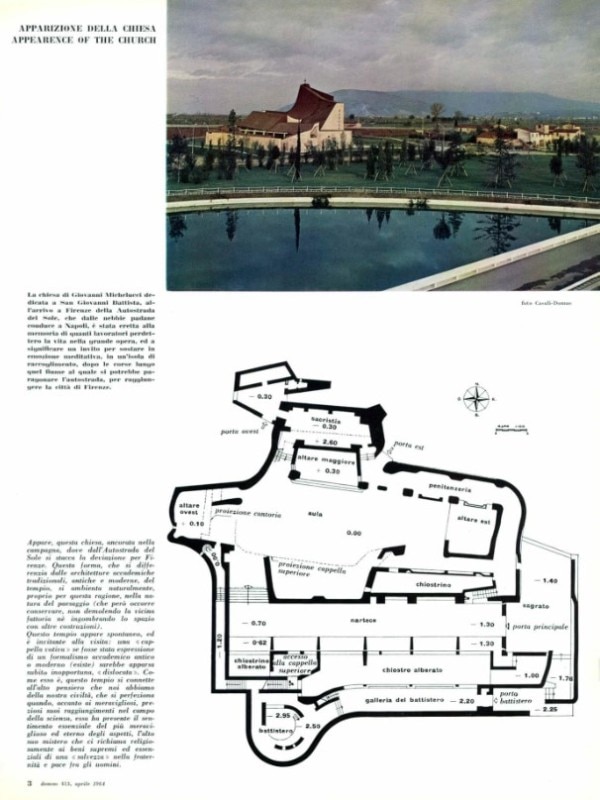
And this is undoubted to those who visit Michelucci’s church, which is ancient and modern at the same time, handmade with ancient techniques (by old surviving stonemasons, and master masons way down into their sixties), and simultaneously with the most modern and courageous concrete structure of the tented vault and concrete struts that hold it up. Architecture “ancient and modern” means “perennial”, as perennis religio est. This perenniality is then the perpetuity that is said by Palladius to be an attribute of (good) architecture (as it is an attribute of every good work of art and truth).
As we wait for time to pronounce on this work by Michelucci as it deserves, we take comfort in saying that it is the masterpiece of his life, wisdom, philosophy, and infinite passion as an architect; and it is a mirror of the severe and high thoughts that exclusively inspired him.
This church has a strength, how shall I say? austere but not haughty, indeed of that modesty and dignity with which only the house of God can be thought of. And God’s house it is, grand in afflatus, and small instead in measure, solid as a fortress, as a security; not rich but sovereign: and musical with poetic silences. Its structures, its white cements that have taken up and deferred with lights like a dust of morning gold, are, see them in the illustrations, trees, to whose branches the inverted vault is tied, the tent. This church in Campi Bisenzio is inspired in reference to biblical and evangelical mottos that remind how a tent would help to protect faith, as such faith is strong in hearts, before being strong in shelters. Michelucci’s thoughts were already foreshadowed in this expression. A providence for architects, truly divine, provides for these encounters between the architect’s secret thoughts and the work that comes to resurrect them.
And this happens even better in the mature age, and in old age, which in architects is marvelous with discoveries and learnings, aided by the fleeting time.
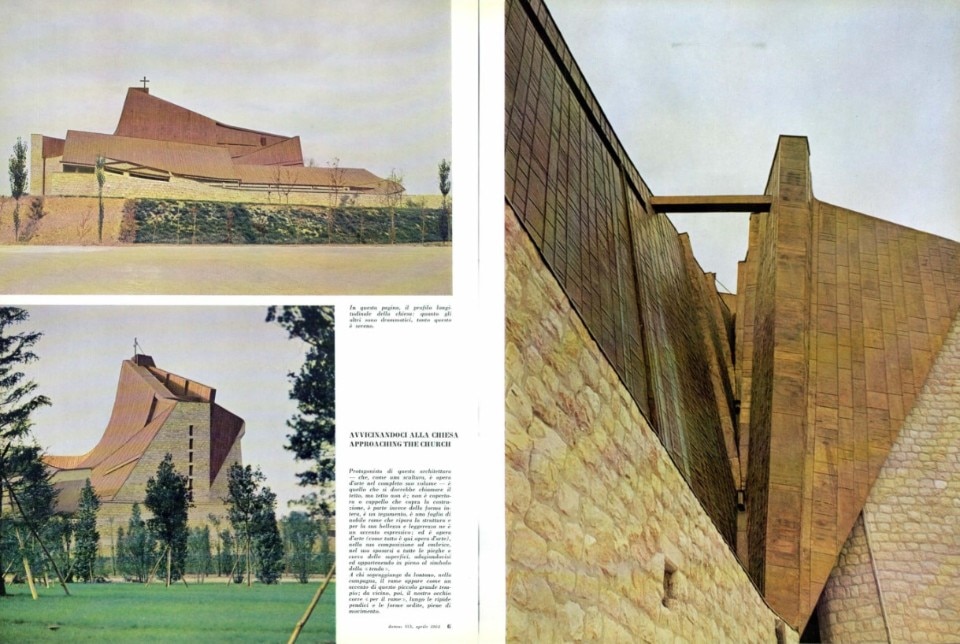
Within the discourse of contemporary culture it is not enough to read just one magazine, even if one loves it, and as we invited readers to visit Michelucci’s church, and himself, we invite them to find and read the issue 76, February ’62, of “L'Architettura “, edited by Zevi, dedicated to Michelucci; already in scrolling through those pages in the chapters devoted to his “thoughts” we will see architecture taking shape inside him : here are the titles of those chapters : “too often one lives and works as if one were alone...” – “I think that in order to detach oneself formally from the past, it is necessary to be enriched to the utmost with the content of the past” – “the supermarket offers a structure that brings out certain vital elements that are proper to the modern city” – “skillfulness has gone as far as play” – “if people like these buildings of mine it is because they are closer to houses for celebration than to monuments” – “I was free from the forms of the old city enclosed with walls and towers” – “the street” – “the tent”… and read Leonardo Ricci’s stupendous essay on “Michelucci the man”, stretching through the landscape of his buildings, in which after the rectilinear structures, gradually the design moves into the plans, and the vision is articulated in the elevations already approaching in the Belvedere church the use of concrete – because a concrete roof is not a structure but a stretched canvas – not in terms of subjection to some technical-structural economy, but of an employment in the service of the architect’s will to create and configure spaces, with fluency and I would say irreverence to the rhythms and ways in which cement structures have presented themselves to us, and turning them finally to our use and inspiration, as a mason rather than a calculator. From Leonardo Ricci, in words from time to time more beautiful and moving, the reader will be led to the Church of the Sun Highway, and to that of San Marino which will follow it, and to the augury of other works.
We, lingering under his tent will put emphasis on the atmosphere he created within this symbol, as those who visit his church will feel.
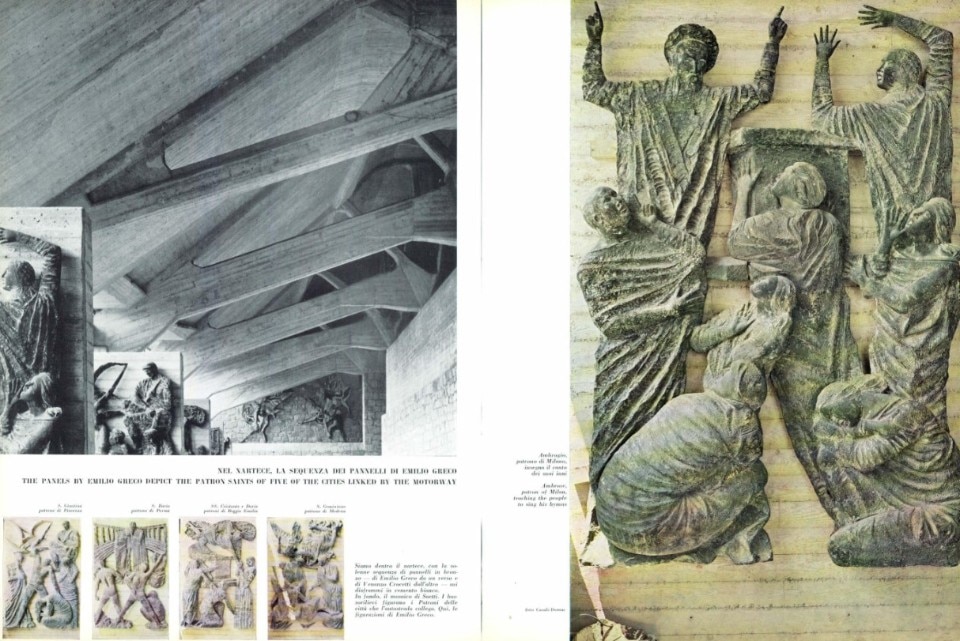
Which then, so genuine is it that it is vernacular and country, and it is Tuscan; I cannot explain it, but it is. It has also been written that it is made so that the many who run on the highway will pause, and man will meet himself. I will say that he will meet God, because it is precisely by this way of the mystery that is sealed in each of us living, that we come to know the supernatural, from which descends the knowledge of everything, and the inspiration of every gesture.
And that this invitation comes from a Catholic church, which of Christianity harbors the images and symbols, and the historical and dramatic allegories and evocations, is the highest honor and rank that can be attributed to it, for it is of Christianity to call men to this elevation of thoughts in the name of a brotherhood (asserted even with heroic price of sacrifice) among men, so that in our " civilized " consciences we cannot but think of all men, in the religious presence of the supernatural, of God, and in the words of Jesus.
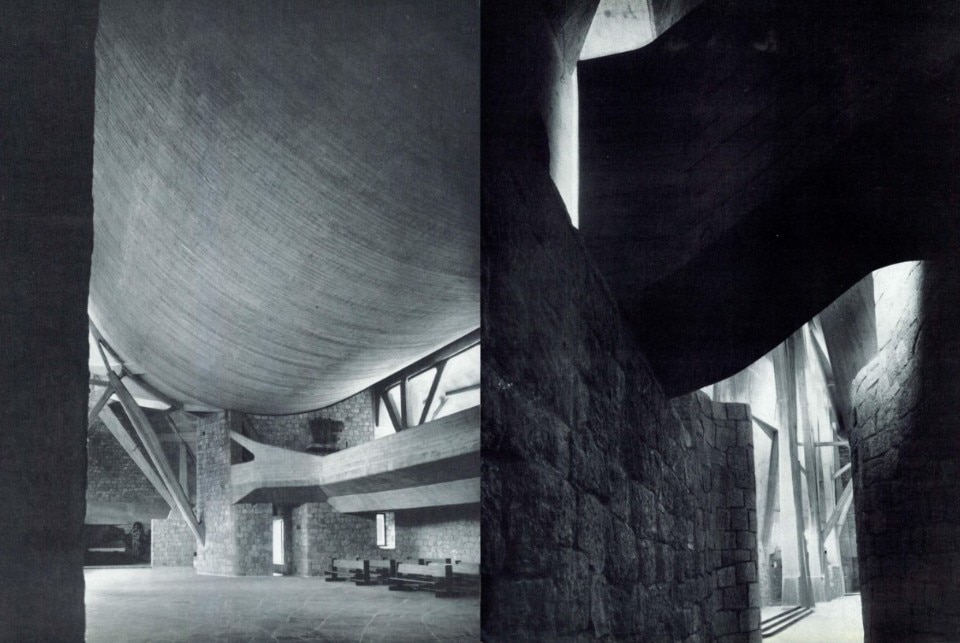
Emphasis has thus been placed on the genuineness of Michelucci's work, because this call is not mediated by architecture, but comes through "his" architectural expression, from him, from a man's voice, expressed in a work whose singularity represents truth; think what would have been of import, a formally "academic" and "traditional" church in that place; instead of this church happened there, flown there, from the highway itself, and sprung up like a tree, from a seed carried by the wind.
With this episode skirting the rapid river of the highway, an expression of our civilization is fulfilled, which to be true, that is, whole, must have the place where man's encounter with the supernatural and, at the same time, with conscience can take place.
Praise be to those who wanted it, and thus honored in the highest way their dead in labor. And for this church the Highway of the Sun, reattaches itself to our roads that lead by famous architecture through cities, places and castles. Our other highways are orphaned of architecture.
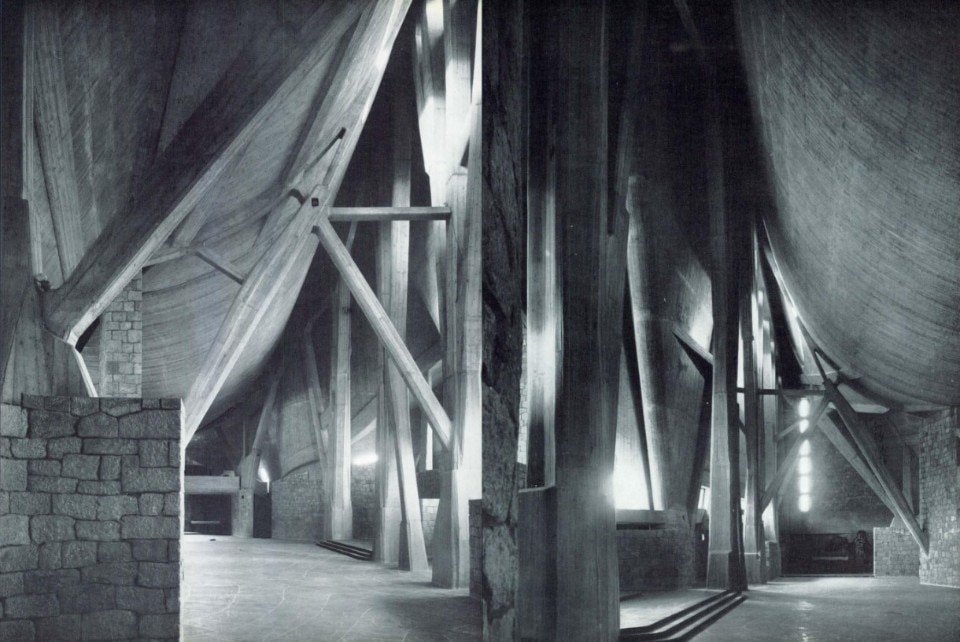
I wrote one day, "Building a church is like rebuilding religion, returning it to its essence, to the Mystery, to the Divine, to the Sacred." You did that, Michelucci, and we thank you for it. But I also corrected that writing of mine like this, " it is like reconstructing, first within ourselves, religion, returning it first within ourselves, to its essence." You have done that, and we recognize it in your work.
(Someone insinuated to me: telling Michelucci that he can die happy now, how distasteful: away. What a fool, Michelucci, that fellow! what a prefabricated man! as if people like you and me at our beautiful age were not always accompanied by the strong thought of dying without fear of dying, thanking God for this bestowal: as if that thought were not the highest that is permitted to a man, the one that brings him closest to God; as if in it a man were not finally "liberated" as long as he lives - and in the hope of living long - to think well and operate well in his art; as if in operating that thought, among so many unhealthy and uncertain affairs, there were not the most beneficent, generous, sure and certain guidance, in the most certain affair! As if to be able to die happy for the mastery of one's work were not the highest wish, the greatest comfort, indeed the only one, to our life of architects. But those who love and admire you, Michelucci, consider you a master, and pray that this last happiness is still far off to be even richer in works.


